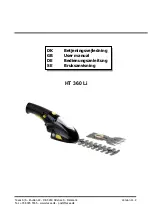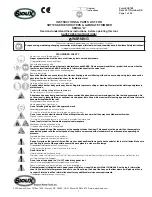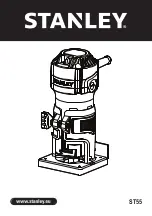
GB-3
2) Electrical safety
a) The mains plug of the power tool
must fit into the mains socket.
The plug must not be modified
in any way. Do not use adapter
plugs/connectors in combina-
tion with tools with protective
earthing.
Unmodified plugs and
fitting sockets reduce the risk of
electric shock.
b) Avoid physical contact with
earthed surfaces as pipes, heat
-
ers, ovens and refrigerators.
There is an increased risk of elec-
tric shock if your body earthed.
c) Keep the tool out of the rain.
The
penetration of water into a power
tool increases the risk of electric
shock.
d) Do not use the cable to carry or
hang up the tool or to pull the
plug out of the socket. Keep the
cable away from heat, oil and
sharp edges or moving parts
of the tool.
Damaged or tangled
cables increase the risk of electric
shock.
e) When operating a power tool
outdoors, use exclusively exten
-
sion cables that are approved
for outdoor-use.
The use of an
extension cable that is suitable for
outdoor use reduces the risk of
electric shock.
3) Personal safety
a) Always pay attention to what you
do and apply reasonable care
when working with a power tool.
Do not use the tool when you
are tired or under the influence
of medication, drugs or alcohol.
When working with power tools
even a short moment of inattentive-
ness may result in severe injury.
b) Wear personal protection equip-
ment and always wear eye pro-
tection (safety goggles).
Wearing
personal protection equipment as
a dust mask, nonslip safety shoes,
safety helmet or ear protectors (de-
pending on the type and use of the
tool) reduces the risk of injury.
c) Avoid unintentional operation.
Make sure that the switch is
in ‘OFF’ position before pulling
the plug from the mains socket.
When carrying the tool with your
finger on the on/off switch or con
-
necting the tool to the mains supply
with the switch in ‘ON’ position, this
may result in accidents.
d) Remove adjustment tools or
wrenches and the like before
you switch the tool on.
A wrench
or another tool that is inside or on
a turning part of the tool may cause
injury.
e) Do not overestimate your abili-
ties. Take care of a safe footing
and keep your balance at all
times.
This will allow you to better
control the tool in unexpected situ-
ations.
f) Wear suitable clothes. Do not
wear wide clothing or jewel-
lery. Keep your hair, clothes and
gloves clear of all moving parts.
Loose clothing, jewellery or long
hair may get caught in moving parts.
g) If dust extraction/collection de-
vices are provided make sure
GB
| Operating Instructions
Summary of Contents for EHS 650
Page 3: ...A B 2 2 3 4 5 C 6...
Page 4: ...7 8 3 9 8 mm...







































